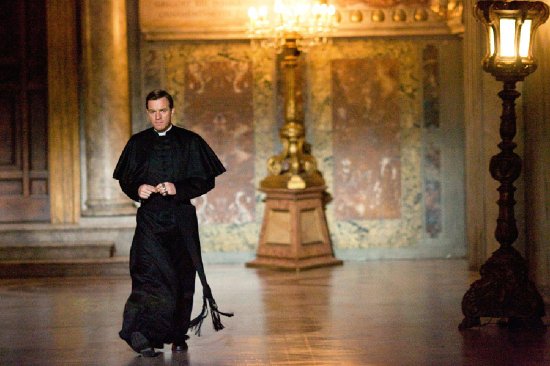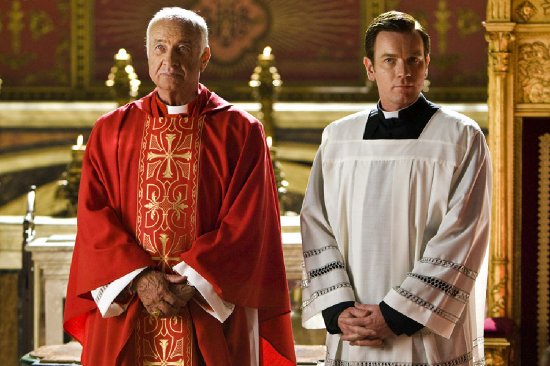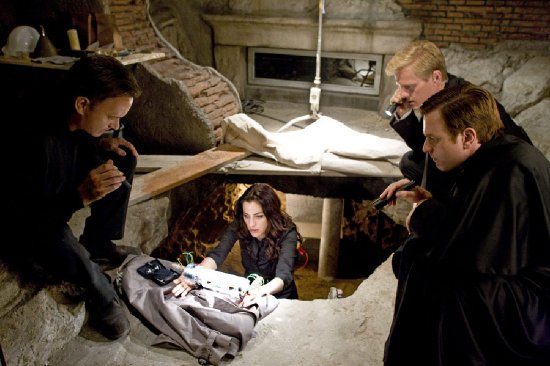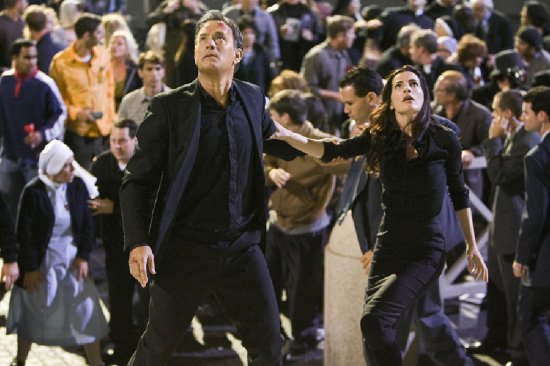Angels & Demons
Introduction
If it wasn't bad enough that Dan Brown's The Da Vinci Code had symbologist Robert Langdon getting the Church's knickers in a twist with a theory that Christ provided a living descendant through Mary Magdelene (which is quite feasible, except maybe the bit about him ending up in Scotland where the SPL clearly needs a miracle…), the follow-up Angels & Demons sees a conspiracy where the heart of the Catholic Church is threatened by a secret organisation called the Illuminati.
Langdon (Tom Hanks) is summoned to the Vatican, shortly after the seemingly unrelated death of the current Pope, as a canister of recently created anti-matter has been stolen from Swiss research centre CERN and hidden in the Vatican City by the Illuminati. The Illuminati were an ancient order comprised of artists, architects and scientists (including Raphael and Galileo) whose beliefs put them at odds with the dominance of the Catholic Church, despite these people also being religious believers. In 1660 the Catholic Church carried out La Purga which included the public branding of four leading members of the Illuminati and drove the remaining members underground.
Revenge is a dish best served cold and now, some four hundred odd years later, that time has come. The four likely candidates to the succeed the Pope have been kidnapped and will be executed one per hour from 8 o'clock and then the chamber of anti matter will explode under the Vatican City at midnight, utterly destroying it. With enthusiastic support from the Pope's number 2, the Camerlengo (Ewan McGregor), Langdon and CERN scientist Vittoria Vetra (Ayelet Zurer),must decipher the clues within Rome's impressive architecture and follow the Path of Illumination across Rome to attempt to save the lives of the missing Cardinals and recover the stolen anti matter…
Picture
Superb picture that really brings the opulence of the architecture and décor of the Roman Catholic Church out in full, despite the fact that there is a mass of seamless CGI in here due to Ron Howard and co being unable to film within the Vatican City.
This is a film that really highlights just how good a format Blu-ray is in terms of picture quality.
*note* these pictures have not been captured from the BD release of this film and are included for purely illustrative purposes...
Extras
Extended Version of Film - adds an extra 7 minutes of footage to the Theatrical Version, and you can watch either. Having read the book but not seen the film in the cinema, I just dived into the Extended Version straight away.
The Path Of Illumination - this is an interactive extra that is best described as an audio-visual encyclopaedia of the film and subject matter. A series of menus will give you information on the film and also items or terms of interest that are related. Nice idea but I got a bit bored of using my remote after a couple of minutes, I much prefer passive extras myself…
Rome Was Not Built In A Day - a look at the production design of the film, focussing on the fact that most of the great sets within the Vatican City were reproduced either on a huge carpark in Los Angeles or in a computer.
CERN: Pushing The Frontiers Of Knowledge - Featurette that is a well deserved advert for the Swiss-based organisation and not only provides a timely reminder of the origins of the World Wide Web but maybe also another reminder that the Large Hadron Collider project is not the end of mankind as was hyped in the press not too long ago by those who couldn't do their own research.
Angels & Demons: The Full Story - rather brief Making Of featurette.
The sleeve artwork boasts over 90 minutes of extras but is nowhere near in my view as the featurettes are only ten minutes each approximately. So 30 minutes (plus a couple extra, give or take) and the extra 7 minutes for the Extended Version leaves just under an hour for the Path of Illumination extra, which is possible but if everyone gets as bored as I did virtually straight away then you'll feel a little cheated by it. There was so much more that they could have done and it just feels like they scrimped on this.
Overall
One of the complaints about The Da Vinci Code was that it spent too long chatting to itself and not enough action in it to carry the interest beyond the original premise. Director Ron Howard appears to have taken this on board for the sequel (despite the fact that in literary terms it came first) and has created a non-stop chase film that rarely stop to catch it's breath.
Those who have read the book recently may well be disappointed with some of the changes made to the screenplay but as someone who read it well over a year or so ago, I took all the changes in my stride and recognise that this made for a much better film despite losing a couple of characters that made the book what it was. The majority of characters in A&D are well rounded and fleshed out bar CERN scientist Vittoria, who appears to be nothing more than Langdon's sidekick, only there to point out that the battery is fading on the anti matter canister and hopefully be able to swap Duracells before the bunny stops and there's an explosion like no other. Relegated to a bit part actually helps in this instance as she therefore doesn't need to do too much other than run around or hold Langdon's hand (in a non-sexual way, of course) and is definitely not the romantic interest - which this film doesn't need in the slightest.
The architecture of Rome and the Vatican City looks gorgeous on BD, and a lot of it isn't even real - not that you could tell. Ron Howard wasn't allowed to film with the borders of the Vatican City (duh, really?) and so had to rely on good production design and CGI in order to pull off the impressive opulence of the renowned architecture, and his team didn't let him down. You'd be hard pressed to watch this film and think that most of it was fake, especially the rather splendid take on St Peter's Square.
I like Dan Brown's output, it may be modern pulp fiction and simplistic to some but his books certainly are page turners, and at least his stories have a tendency to make you think with the current two film adaptations looking at the roots of the Church and his latest (released this week) throwing a spotlight on Washington DC and the Freemasons. I liked The Da Vinci Code more as a book than film, but suspect that was due to my reading of the book just prior to seeing the film. Coming at this adaptation from a distance and despite knowing what's going to happen and who the mystery villain is, I think that that Angels & Demons is a much better film than The Da Vinci Code and a worthy addition to anyone's collection, even if they have skimped on the extras here…





Your Opinions and Comments
The story has more twists and turns than a Curly-Wurly left on a radiator, and all the actors acquit themselves admirably. The Blu-ray comes with both Theatrical and Extended cuts - the former being the less gory of the two. If I have any complaint about the picture it's the godawful cod science about antimatter, described by the heroine as a "combustible material", which is a bit like describing a hydrogen bomb as a method of warming your hands.
The extras on the disc go into detail about recreating the Vatican for the screen, and a number of sequences are absolutely gobsmacking in their fakery which I as a long-standing effects-spotter had taken to be 100% genuine.
If I was using the term among dyed-in-the-wool film snobs or Home Theatre types, I'd only feel safe using it in terms of something with critical acclaim as well as exceptional image quality. And critical acclaim is no guarantee of entertainment value.
It's a balancing act. Of course, YMMV.